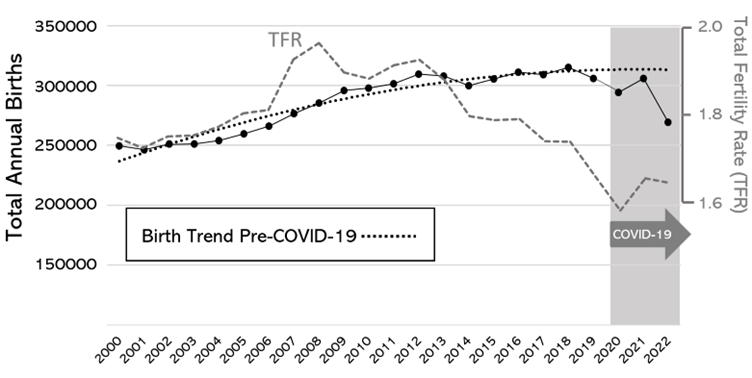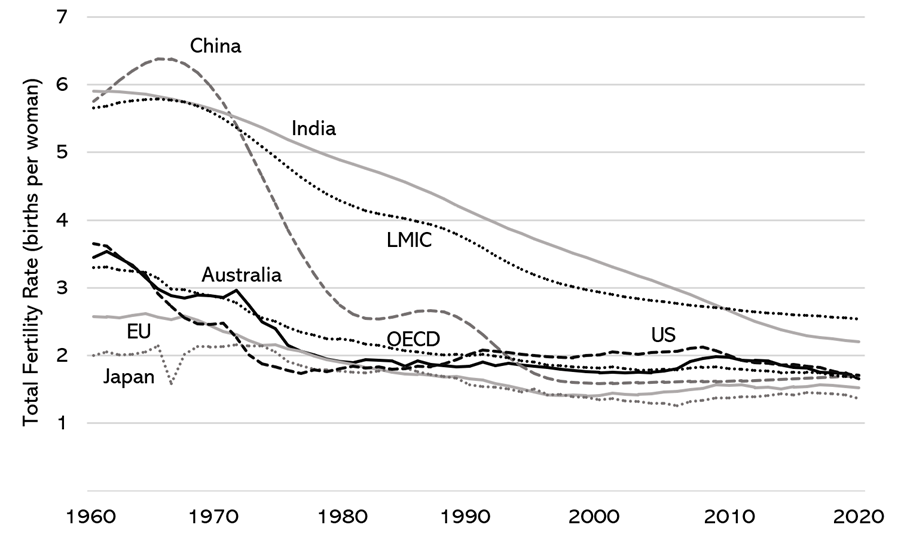2024 must be the year of the baby
Originally published insightplus.mja.com.au
The “baby bust” must be part of Australia’s political agenda, so we can overcome this existential crisis, write Dr Clare Boothroyd, Dr Katharine Bassett and Professor Steve Robson.
The “baby bust” is a unique and existential crisis, never before encountered in human history. In 2020, fewer than 300 000 babies were born for the first time since 2007, and the total fertility rate (TFR) estimate for the year had fallen to 1.58 babies per woman over the lifetime. This is the lowest TFR in Australia’s history, representing a fall of 56% from the peak in 1961 (when the TFR reached 3.55 babies per woman).
Although a slight rebound in the number of babies born was observed in 2021, perhaps the result of people delaying pregnancy rather than abandoning the idea altogether, the fertility situation again appeared grim with release of the latest 2022 statistics. Australia’s TFR has remained stuck below 1.7 babies per woman since before the coronavirus disease 2019 (COVID-19) pandemic, the longest period in the nation’s history.
These cumulative results rung alarm bells, prompting former Australian federal Treasurer and architect of the “Baby Bonus” initiatives of the early 2000s, Peter Costello, to make a public call for new policy measures to increase Australia’s birth rate.
In the most recent Intergenerational report, released by the Australian Treasury in 2021, the significance of falling birth rates for Australia and its economy was noted but not addressed. The Treasury comments were predicated on concerns that, “for the first time in an intergenerational report, the population projection is being revised down”. An ageing population has a number of well recognised and interrelated effects:
- an increased need for social services;
- increased demand for health care;
- increased demand on pensions;
- a reduced labour supply and likely reduced productivity of older participants in the labour market;
- a likely reduction in unemployment in the younger members of the population.
As an example of just how high the stakes are, we need only look to Japan, where the twin threats of catastrophically low birth rates and a ballooning elderly population are rapidly coalescing. At the beginning of 2023, Japanese Prime Minister Fumio Kishada told the world “Japan is standing on the verge of whether we can continue to function as a society”.
The factors influencing birth rates
It is tempting to blame the “baby bust” on effects of the COVID-19 pandemic but, in reality, the pre-pandemic year 2019 also had a historical low TFR of 1.66 babies per woman. Indeed, Australia’s birth rate has been in established decline over the decade prior to the COVID-19 pandemic (Figure 1).

Putting this in a global context, the data for fertility rates in Australia are not unique: across the globe, birth rates and resulting TFR estimates have been in decline since the 1960s (Figure 2).

In January 2023, Treasurer, the Hon Jim Chalmers MP, announced unprecedented increases in migration rates, with as many as 300 000 new arrivals expected yearly in the short term, providing a boost in the availability of human capital. Studies suggest that migrants generally have higher TFRs. However, this has not proven to be the case in Australia.
Replacement-level fertility rates will keep a country’s population steady but will not lead to population growth if mortality rates remain unchanged and migration has no effect. Virtually all high income countries now have TFRs well below replacement level (here), with population increases dependent upon migration. Migrants generally do not arrive as newborns, so migration-based population increases distort the age distribution of a population with a skew towards older ages, with a resulting increase in the proportion of older people in the population.
Education of women is a significant component. Globally, there is a well recognised negative relationship between a woman’s level of education and the ultimate size of her family. The situation is no different in Australia, where women are investing time, effort and money in increasing their education. That is great news, but it will affect fertility. There is evidence from the United States that the greatest reduction in family size are women from disadvantaged backgrounds who receive tertiary education. Improved education usually makes life better for people, but the trade-off will be further reductions in birth rates. For this reason, increasing the flexibility of educational options will need to be an early and key policy target.
What can be done?
Convincing a large number of women and their partners to have an additional child will be no easy task. Indeed, pro-natal policies introduced in high income countries around the world have had, at best, patchy success. Australia’s own “baby bonus”, a suite of financial incentives for new parents introduced in the mid-2000s, for a short period of time had a modest effect on the birth rate and, importantly, resulted in an increase in a third child being born (here). Paid parental leave policies, which Australia has had for over decade now, have been recognised globally as having a positive effect on fertility, at least in the short term. We welcome the Australian Government’s recent announcement of women on maternity leave being paid superannuation, but more needs to be done.
The first step will be moving babies and children up the national priority list. To justify this will require taking the community along on the fertility journey. Unfortunately, most political objectives barely span the electoral cycle. If we are to increase Australia’s population through birth, then a very long term view will be required.
In addition, there needs to be general support to become a family-friendly society. This will mean starting a national conversation about the long term economic importance of having children, supporting current and prospective parents, as well as supporting family members such as grandparents who may have to help in the raising of children. This would have to become our social purpose for the next 25 years.
The most common family size in Australia is two children, yet studies report that the most commonly desired family size is actually three children. Economic incentives to increase birth rates might usefully be targeted at a third child, taking the approach that families might respond to different incentives for a first child as compared to a third or fourth child. The nature of incentives would need to be broad as well, and include support of quality, possibly work-based childcare, afterschool care centres as well as schemes that provide support to university students who wish to parent children.
For better or worse, it is important to understand and accept that the appropriate biological age for women to have children is between 20 and 35 years, and we all need to facilitate sufficient social change to allow this. One way is to encourage egg freezing by the age of 34 years (and earlier if the woman has a low number of eggs), at an age when eggs are healthy. With modern techniques, the freezing of eggs is now effective and should be considered for Medicare funding in Australia. It is quick, safe and inexpensive compared with the consequences of not preserving fertility.
Case studies from around the world demonstrate that there are few low hanging fruits left, and no easy answers. The “baby bust” is a unique and existential crisis, never before encountered in human history. To overcome it, we will need to be adaptive and insightful. Let us pool our resources to find the best solutions so we do not follow the course of some other countries. Let us make this part of our political agenda.
Dr Clare Boothroyd is a female fertility specialist and obstetrician gynaecologist in Brisbane and the President of the Asia Pacific Initiative in Reproduction.
Dr Katharine Bassett holds a PhD from the Australian National University and conducts research focused on health system reform.
Professor Steve Robson is an obstetrician gynaecologist in Canberra.
Recent Posts










